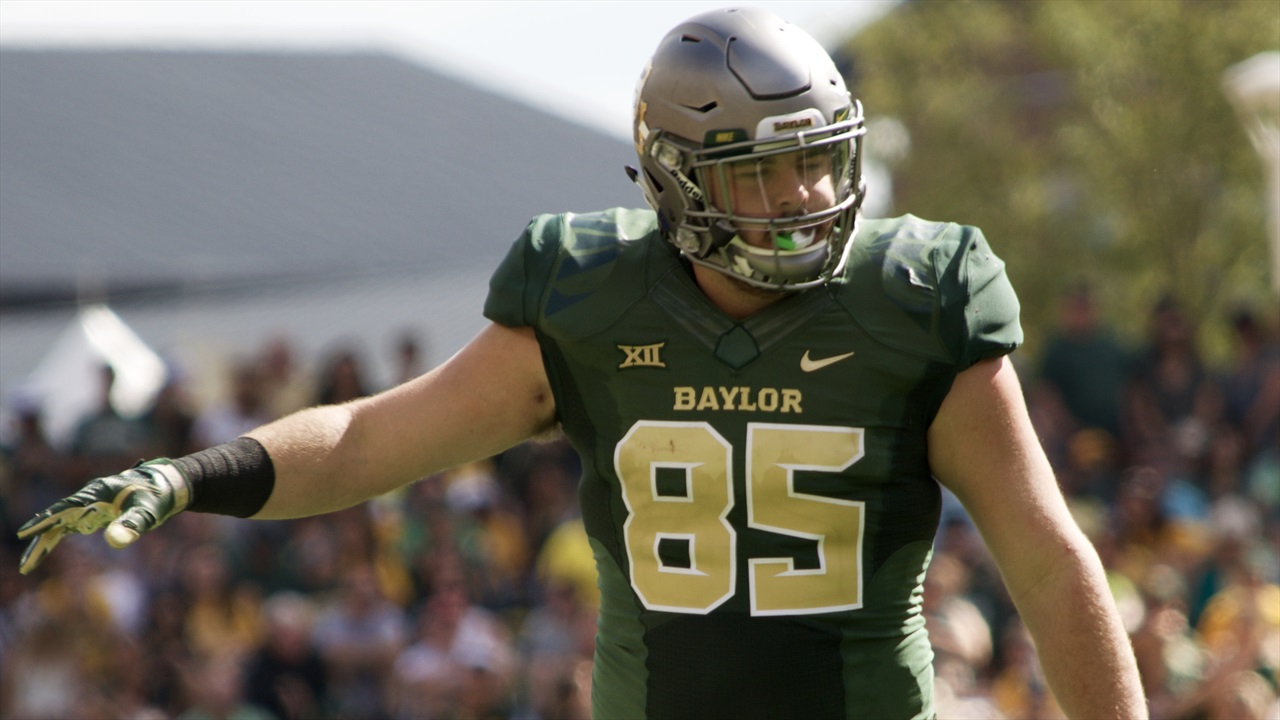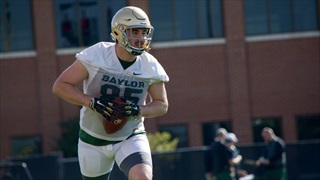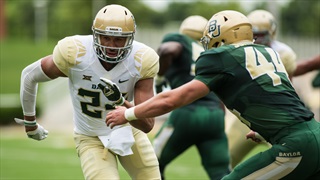
Baylor Football
Midweek Breakfast: Projecting the usage of tight ends under Rhule
A key and expected observation from Baylor's Green and Gold game was the impact of the tight end position from start to finish. Considering the offensive scheme transition that Baylor is beginning to undergo, I wanted to delve into the recent history of the use of the tight end within Art and Kendall Briles’ spread, but most specifically, what type of impact Chip Kelly’s offensive scheme could have in Baylor's new-look offense.
 SicEm365 Senior Jordan Feuerbacher led Baylor tight ends with 7 receptions for 104 yards and two scores in 2016.
The past few years in Waco tight ends have been almost non-existent within the passing game. In 2014, four different tight ends (Tre’Von Armstead, Jordan Feuerbacher, Laquan McGowan, Gus Penning) caught nine passes for 97 yards. Yes, nine total receptions out of 323 – meaning they took part in 2% of the entire passing game.
SicEm365 Senior Jordan Feuerbacher led Baylor tight ends with 7 receptions for 104 yards and two scores in 2016.
The past few years in Waco tight ends have been almost non-existent within the passing game. In 2014, four different tight ends (Tre’Von Armstead, Jordan Feuerbacher, Laquan McGowan, Gus Penning) caught nine passes for 97 yards. Yes, nine total receptions out of 323 – meaning they took part in 2% of the entire passing game.
In 2015, we saw passes to McGowan (2-23), Penning (6-109), and Trevor Clemons-Valdez (1-9). Once again, nine total receptions and a mere three percent participation within the passing game.
In 2016, we saw Feuerbacher (7-104) and Sam Tecklenburg (3-40). That’s only one more reception at the position than the past two seasons. Together, Feuerbacher and Tecklenburg combined for three percent of the passing game.
All in all, the TEs under Briles were typically utilized as an extra blocker that occasionally ran routes, most often to catch the defense by surprise and gain a good chunk of yardage. While Baylor's tight ends did make several big catches over the last few seasons, by looking at these statistics, we can see that the tight end had no importance whatsoever in the passing attack.
With little to no impact in the passing game, the position was utilized rarely within the running game. When used, the Bears rushed for, on average, five yards per attempt over the past three seasons which can be credited to the help of the heavy-set tight ends.
After watching a few teams coached under Kelly and looking at the statistics, the tight end position was used quite differently than Briles. Kelly utilized his tight ends frequently in the passing game at Oregon and while in the NFL as the Eagles and 49ers head coach.
At Oregon, Kelly’s tight ends were typically more athletic. However, they had some meat to them
 Todd Nickle Former basketball player Ishmail Wainright will test his skills on the field for the Bears this fall.
– think bulked wide-receiver. For comparisons sake, take a look at the build of Baylor's 2017 tight end signee Tyler Henderson and recent basketball convert Ish Wainright.
Todd Nickle Former basketball player Ishmail Wainright will test his skills on the field for the Bears this fall.
– think bulked wide-receiver. For comparisons sake, take a look at the build of Baylor's 2017 tight end signee Tyler Henderson and recent basketball convert Ish Wainright.
In 2010 at Oregon, David Paulson was the star tight end for the Ducks with 24 receptions for 418 yards and four touchdowns. In 2011, Paulson was once again Kelly’s number one guy as he hauled in 31 receptions for 438 yards and six touchdowns. Colt Lyerla, who would step into Paulson’s role the following year as he had seven receptions for 147 yards and five touchdowns during the 2011 campaign.
As Kelly’s key player at the position in 2012, Lyerla collected 25 receptions for 392 yards and six touchdowns. There were only two others in 2012 at the position that caught passes at the tight end position, Pharaoh Brown (2-42) and Koa Ka’Ai (2-18).
On average, Kelly’s spread used the tight ends a total of 11 percent within the passing game. While this percentage seems quite low, when you compare it to Briles’ tight ends, it’s nearly four times the amount. As well, Kelly’s tight end gained a significantly greater amount of yards than Briles.
While the offense at Oregon overall produced huge numbers each season and had an astonishing record during Kelly’s four-year tenure (46-7), tight ends did not have a role as significant in his collegiate spread attack as it would when he made the transition to the NFL.
In 2013, Kelly attempted to introduce his high-octane offense to the NFL as he was hired in Philadelphia. Kelly’s offense began to morph as the newness of the spread wore off and teams began learning how to defend the spread.
While Kelly continued to use his tight ends heavily in the passing game like college, the no huddle offense was not the same. Zach Ertz (36-469-4) and Brent Celek (32-502-6) were the go to tight ends in Philadelphia. Even though both put up decent numbers and among the top 20 fantasy tight ends for the season, I think it’s important to note the fact that both were number five and six in the passing game for the Eagles.
In 2014, the two combined for similar numbers on the season, but Ertz's production increased significantly. Ertz caught 58 receptions for 702 yards and three touchdowns while Celek caught 32 for 340 and one touchdown.
The next year, Kelly’s last in Philadelphia, Ertz improved once again to college 75 receptions for 853 yards and two touchdowns while Celek had 27 receptions for 398 and three touchdowns.
An interesting trend that can be seen from Kelly’s time as the Eagles head coach was the increasing use of his tight ends as their receptions and yardage grew.
After being fired from the Eagles, Kelly was hired as the 49ers head coach for the 2016 season. With one of the worst rosters in the NFL, Kelly’s offense struggled to produce. Tight ends under Kelly in the Bay Area were Garrett Celek and Vance McDonald. Both produced mediocre numbers, hauling in a combined 53 receptions for 741 yards and seven touchdowns with Celek hauling in the majority of catches, 29.
 SicEm365 Baylor senior Quan Jones made the move to tight end for his senior season in 2017.
While Kelly’s tight ends productivity within the college game far exceeded that of Briles or even Rhule while at Temple, it is equally important to look at Kelly’s spread at the professional level as it reflects, in my opinion, what Rhule will try to do.
SicEm365 Baylor senior Quan Jones made the move to tight end for his senior season in 2017.
While Kelly’s tight ends productivity within the college game far exceeded that of Briles or even Rhule while at Temple, it is equally important to look at Kelly’s spread at the professional level as it reflects, in my opinion, what Rhule will try to do.
Rhule will utilize a power spread per se that merges Kelly’s NFL spread and a ground and pound style. This ground and pound style can be seen at Rhule during his time at Temple.
In 2015, Temple featured three tight ends: Kip Patton, Saledeem Major, and Colin Thompson. Being on the field around 90 percent of the time, the three were utilized often and were key to Rhule’s offense.
In the passing game, Patton led the trio with only 12 receptions for 168 yards. Major caught six targets for 96 yards and one touchdown and Thompson finished with five catches for 67 yards.
When they weren’t involved in the passing game, they were involved in the rushing attack. The Owls rushed, on average over the last two years, 40 times a game for around four yards per carry. This productivity can be attributed to the efforts of the offensive line in combination with the tight ends.
What can be taken from these numbers, as well as by watching their games, is that a requirement of Rhule’s tight ends is the ability to block while being athletic enough to run routes.
While the spring game showcased the increased usage of the tight end, I don’t believe it is at all what we will see as Feuerbacher and Ishmael Wainwright hauled in only three catches for 61 yards.
If Rhule does indeed use the tight end similar to Kelly at the NFL level, you can expect to see more than what he used the players at tight end while Temple and, obviously enough, more than what was seen in Waco in several years.
 SicEm365 Senior Jordan Feuerbacher led Baylor tight ends with 7 receptions for 104 yards and two scores in 2016.
SicEm365 Senior Jordan Feuerbacher led Baylor tight ends with 7 receptions for 104 yards and two scores in 2016.
In 2015, we saw passes to McGowan (2-23), Penning (6-109), and Trevor Clemons-Valdez (1-9). Once again, nine total receptions and a mere three percent participation within the passing game.
In 2016, we saw Feuerbacher (7-104) and Sam Tecklenburg (3-40). That’s only one more reception at the position than the past two seasons. Together, Feuerbacher and Tecklenburg combined for three percent of the passing game.
All in all, the TEs under Briles were typically utilized as an extra blocker that occasionally ran routes, most often to catch the defense by surprise and gain a good chunk of yardage. While Baylor's tight ends did make several big catches over the last few seasons, by looking at these statistics, we can see that the tight end had no importance whatsoever in the passing attack.
With little to no impact in the passing game, the position was utilized rarely within the running game. When used, the Bears rushed for, on average, five yards per attempt over the past three seasons which can be credited to the help of the heavy-set tight ends.
After watching a few teams coached under Kelly and looking at the statistics, the tight end position was used quite differently than Briles. Kelly utilized his tight ends frequently in the passing game at Oregon and while in the NFL as the Eagles and 49ers head coach.
At Oregon, Kelly’s tight ends were typically more athletic. However, they had some meat to them
 Todd Nickle Former basketball player Ishmail Wainright will test his skills on the field for the Bears this fall.
Todd Nickle Former basketball player Ishmail Wainright will test his skills on the field for the Bears this fall.
In 2010 at Oregon, David Paulson was the star tight end for the Ducks with 24 receptions for 418 yards and four touchdowns. In 2011, Paulson was once again Kelly’s number one guy as he hauled in 31 receptions for 438 yards and six touchdowns. Colt Lyerla, who would step into Paulson’s role the following year as he had seven receptions for 147 yards and five touchdowns during the 2011 campaign.
As Kelly’s key player at the position in 2012, Lyerla collected 25 receptions for 392 yards and six touchdowns. There were only two others in 2012 at the position that caught passes at the tight end position, Pharaoh Brown (2-42) and Koa Ka’Ai (2-18).
On average, Kelly’s spread used the tight ends a total of 11 percent within the passing game. While this percentage seems quite low, when you compare it to Briles’ tight ends, it’s nearly four times the amount. As well, Kelly’s tight end gained a significantly greater amount of yards than Briles.
While the offense at Oregon overall produced huge numbers each season and had an astonishing record during Kelly’s four-year tenure (46-7), tight ends did not have a role as significant in his collegiate spread attack as it would when he made the transition to the NFL.
In 2013, Kelly attempted to introduce his high-octane offense to the NFL as he was hired in Philadelphia. Kelly’s offense began to morph as the newness of the spread wore off and teams began learning how to defend the spread.
While Kelly continued to use his tight ends heavily in the passing game like college, the no huddle offense was not the same. Zach Ertz (36-469-4) and Brent Celek (32-502-6) were the go to tight ends in Philadelphia. Even though both put up decent numbers and among the top 20 fantasy tight ends for the season, I think it’s important to note the fact that both were number five and six in the passing game for the Eagles.
In 2014, the two combined for similar numbers on the season, but Ertz's production increased significantly. Ertz caught 58 receptions for 702 yards and three touchdowns while Celek caught 32 for 340 and one touchdown.
The next year, Kelly’s last in Philadelphia, Ertz improved once again to college 75 receptions for 853 yards and two touchdowns while Celek had 27 receptions for 398 and three touchdowns.
An interesting trend that can be seen from Kelly’s time as the Eagles head coach was the increasing use of his tight ends as their receptions and yardage grew.
After being fired from the Eagles, Kelly was hired as the 49ers head coach for the 2016 season. With one of the worst rosters in the NFL, Kelly’s offense struggled to produce. Tight ends under Kelly in the Bay Area were Garrett Celek and Vance McDonald. Both produced mediocre numbers, hauling in a combined 53 receptions for 741 yards and seven touchdowns with Celek hauling in the majority of catches, 29.
 SicEm365 Baylor senior Quan Jones made the move to tight end for his senior season in 2017.
SicEm365 Baylor senior Quan Jones made the move to tight end for his senior season in 2017.
Rhule will utilize a power spread per se that merges Kelly’s NFL spread and a ground and pound style. This ground and pound style can be seen at Rhule during his time at Temple.
In 2015, Temple featured three tight ends: Kip Patton, Saledeem Major, and Colin Thompson. Being on the field around 90 percent of the time, the three were utilized often and were key to Rhule’s offense.
In the passing game, Patton led the trio with only 12 receptions for 168 yards. Major caught six targets for 96 yards and one touchdown and Thompson finished with five catches for 67 yards.
When they weren’t involved in the passing game, they were involved in the rushing attack. The Owls rushed, on average over the last two years, 40 times a game for around four yards per carry. This productivity can be attributed to the efforts of the offensive line in combination with the tight ends.
What can be taken from these numbers, as well as by watching their games, is that a requirement of Rhule’s tight ends is the ability to block while being athletic enough to run routes.
While the spring game showcased the increased usage of the tight end, I don’t believe it is at all what we will see as Feuerbacher and Ishmael Wainwright hauled in only three catches for 61 yards.
If Rhule does indeed use the tight end similar to Kelly at the NFL level, you can expect to see more than what he used the players at tight end while Temple and, obviously enough, more than what was seen in Waco in several years.
Never miss the latest news from SicEm365!
Join our free email list